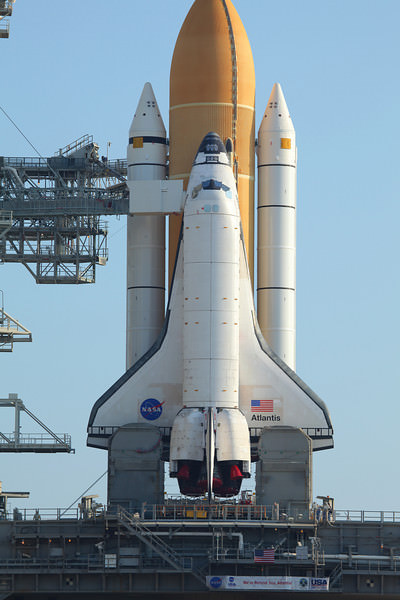[/caption]
On Thursday, the Space Shuttle Program set a target launch date of June 28, 2011 for the STS-135 mission, the “extra” shuttle flight that was approved in the 2010 NASA Authorization Act. The STS-135 mission – if not required as a “Launch on Need” rescue flight for STS-133 or STS-134 — would have the shuttle Atlantis and a 4-member crew carry a fully-loaded Raffaello multipurpose logistics module to deliver supplies, logistics and spare parts to the International Space Station. Whether the mission actually flies, however, depends on if Congress decides to approve NASA’s proposed budget for 2011. There has been rumors that NASA’s budget could be on the chopping block. But NASA needs to begin preparing in case the flight is approved.
According to Jeff Foust’s Space Politics, the House is expected to vote next week on a resolution to cut discretionary spending back to 2008 levels, a move that, if backed up by later appropriations legislation, would cut NASA spending from the $18.7 billion in FY2010 (and $19 billion in the FY11 proposal) to $17.4 billion. There is sure to be a battle, however, from congressional districts in Texas and Florida who worked hard to get the 2010 Authorization Act passed.
After the Act was signed last fall, in late December the agency’s Space Operations Mission Directorate requested the shuttle and International Space Station programs take the necessary steps to maintain the capability to fly Atlantis on the STS-135 mission.
The Authorization Act of 2010 directs NASA to conduct the mission, and scheduling the flight enables the program to begin preparations for the mission. This would be the 135th and final space shuttle flight.
If approved, the mission also will fly a system to investigate the potential for robotically refueling existing spacecraft and return a failed ammonia pump module to help NASA better understand the failure mechanism and improve pump designs for future systems.
The crew consists of commander Chris Ferguson, Douglas Hurley, Sandra Magnus and Rex Walheim. The smaller crew size bypasses the need for a rescue shuttle, as if for some reason Atlantis is unable to return from space, the crew members would be rescued from the station using Russian Soyuz spacecraft.
As far as the next scheduled shuttle flight, STS-133, engineers continue to work on Discovery in the Vehicle Assembly Building Kennedy Space Center to modify the stringers on the external fuel tank. Discovery and its six astronauts are targeted to launch on Feb. 24.
With a bicycle injury to crewmember Tim Kopra, the crew is now joined by Steve Bowen, who flew on the on STS-132 in May 2010, as a replacement. He will be the first astronaut to fly on consecutive missions.
At a press conference on Wednesday, Bill Gerstenmaier, NASA’s Associate Administrator for Space Operations said the astronaut office worked together to figure out who should replace Kopra and figure out the logistics so that the flight would not be delayed even further. “We’ve been working hard on this since Tim had his accident and we think we’ve got a good plan in place,” he said.
“Its was obviously a disappointment for Tim to not be available for this upcoming launch window,” said chief astronaut Peggy Whitson. “He understands that we have to be prepared to fly.”
Whitson said Bowen is a very experienced spacewalker, with five previous spacewalks and very capable in terms of qualifications in the EMU (NASA’s spacesuit). “We felt with a very few additional training runs, he could pick up the timeline, and be able to pull them off with only an additional two runs in the NBL (Neutral Buoyancy Laboratory for each of those two activities.”
The crew also will review robotics procedures today and review spacewalk timelines at NASA’s Johnson Space Center in Houston.
Asked if moral in the astronaut office was taking a hit, with Kopra’s injuries and the possibility of astronaut Mark Kelly stepping aside as commander for the STS-134 mission due to the shooting of his wife, Rep. Gabrielle Giffords, Whitson countered, “Moral here is maybe even better than usual since everyone is pulling together to help the crewmembers during their difficult times.”

